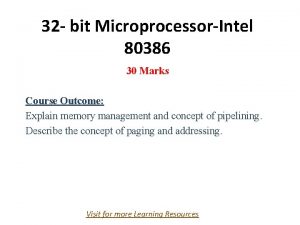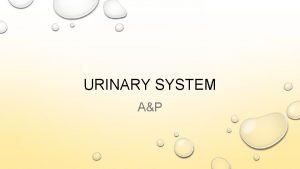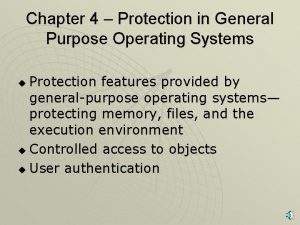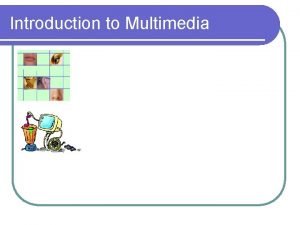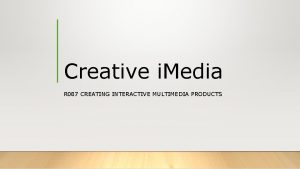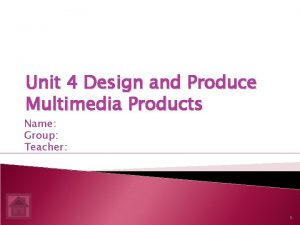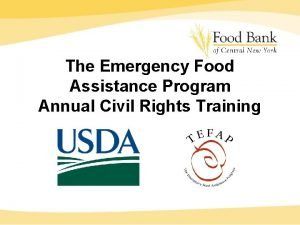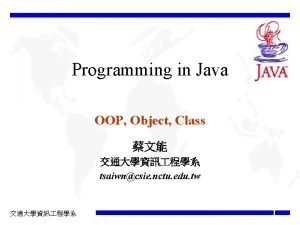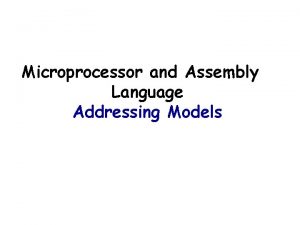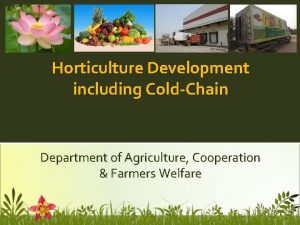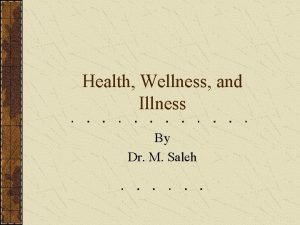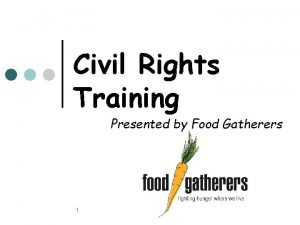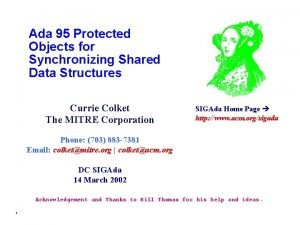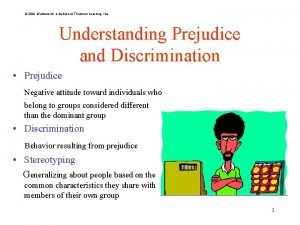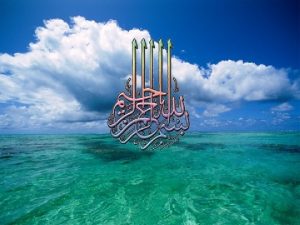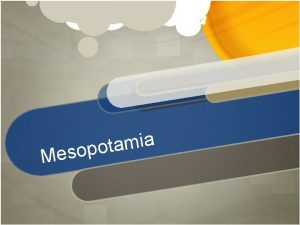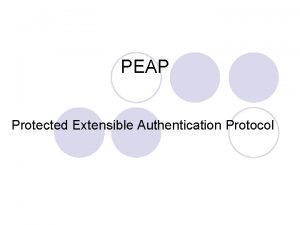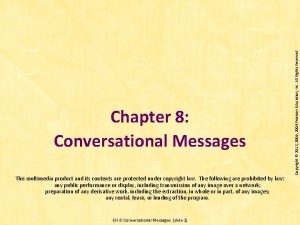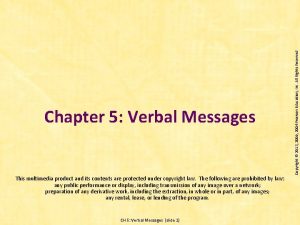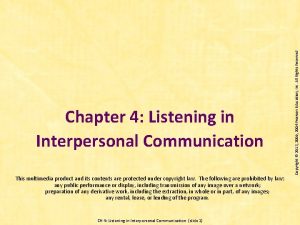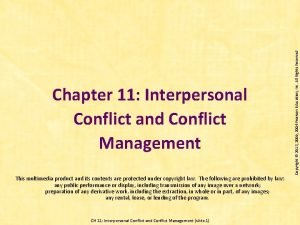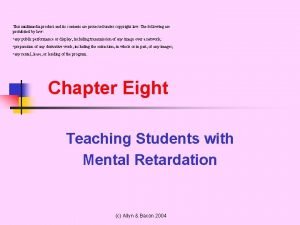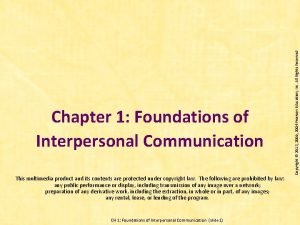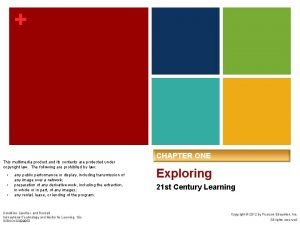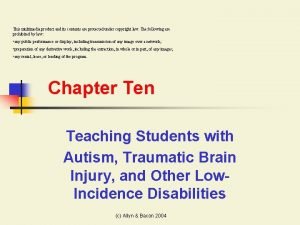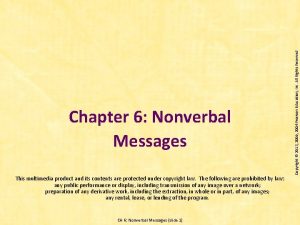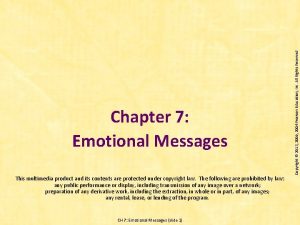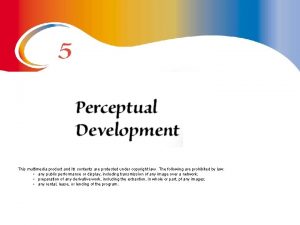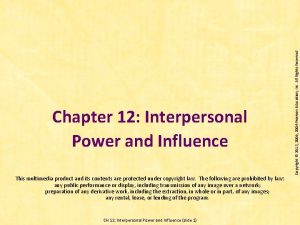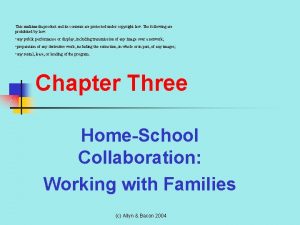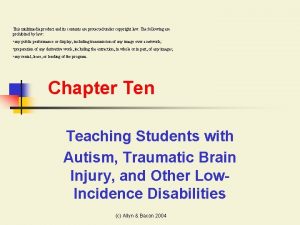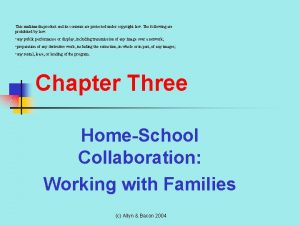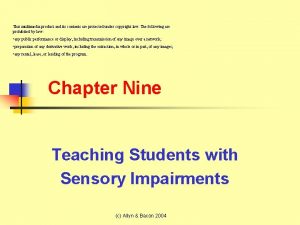This multimedia product and its contents are protected

































- Slides: 33

This multimedia product and its contents are protected under copyright law. The following are prohibited by law: • any public performance or display, including transmission of any image over a network; • preparation of any derivative work, including the extraction, in whole or in part, of any images; • any rental, lease, or lending of the program. Human Body & Nutrition Unit 2: Life Science

The Human Body Ø The human body is a masterpiece of organization. It is composed of millions of tiny cells, many of them differing in shape, size, and internal makeup according to the work they do. Ø Groups of cells that work together are called tissues. • Example: The connective tissue that holds the body together, muscle tissue, nerve tissue, blood tissue, and epithelial (skin) tissue. Ø Tissues that work together are called organs. • Example: The lungs, heart, stomach, and eyes Ø Organs that work together are systems. Ø We will examine the skeletal, muscle, nervous, circulatory, and respiratory systems. Ø At the end, we will briefly discuss nutrition. Copyright (c) 2011 by Pearson Education, Inc.

Students and The Body Ø As students progress through the elementary years, they gain a more comprehensive understanding of the complexity of the human body and the need to care for it through proper nutrition and exercise. Copyright (c) 2011 by Pearson Education, Inc.

Groups of Bones Ø Bones are grouped and well fitted for their specialized work. • The skull contains 8 bones, all joined in a helmetlike shape. • The vertebrae, or spine runs along our back. Between each small vertebrae bone is a pad of tough, elastic tissue called cartilage, which keeps the spinal bones from grinding together as we move. • We have 12 pairs of ribs. They curve around and join the breastbone in front. The ribs form a flexible cage that protects the heart, lungs, and other organs in the chest area. • Hips, arms, and legs- The hips also form the pelvis, a large and open shallow bowl in front of Copyright (c) 2011 by Pearson Education, Inc.

Composition of Bones Ø A soft material called marrow is found inside many bones, particularly the long bones. There are two kinds of marrow. • Red marrow is found at the ends of the bones where red blood cells are manufactured. • Yellow marrow is stored inside the middle of the bones and is mainly composed of fat. Copyright (c) 2011 by Pearson Education, Inc.

Movable Joints Ø We can move because many bones are held together by movable joints. Tough, thick cords of elastic tissue, called ligaments, join bone to bone. We have several kinds of movable joints, and each allows different movements. Ø In all, we have six kinds of movable joints. • Hinged joints allow us to bend the elbow, knee, and fingers. • A ball-and-socket joint at the shoulder allows rotary motion of the arm. Copyright (c) 2011 by Pearson Education, Inc.

Muscles Ø Under the skin and inside the body are about 600 muscles, two thirds of which are voluntary muscles. These muscles are connected to bones, and we can move them on command. Ø Some muscles, such as those that move food through the intestines and those that make the heart beat, cannot ordinarily be controlled. These are involuntary muscles. Copyright (c) 2011 by Pearson Education, Inc.

Tendons Ø Muscles are attached to bone and cartilage by tendons. Ø These are tough, white, twisted fibers of different lengths. Some are cordlike; others are wider and flat. Tendons are enclosed in sleeves of thin tissue that contain a slippery liquid. This lubricating liquid permits them to slide back and forth without rubbing. Ø One of the strongest and thickest tendons in the body is the Achilles tendon, located just above the heel of the foot. Copyright (c) 2011 by Pearson Education, Inc.

Makeup of Muscles Ø A microscope reveals that voluntary muscles are made up of bundles of fibers, each about the size of a human hair but far stronger. Ø The energy to move a muscle comes from a form of sugar called glycogen. It is found inside the muscles’ cells. Ø About one fourth of the energy released by this sugar goes into moving the muscle; the rest is released as heat. The faster a muscle is used, the more heat is produced. This is why heavy exercise makes us warm. Copyright (c) 2011 by Pearson Education, Inc.

The Nervous System Ø The central part of the nervous system is made of the brain and spinal cord. Ø When nerve endings are stimulated in a sense organ, an electrical message is sent through sensory nerves to the spinal cord and then the brain. The brain then flashes back a message along motor nerves, which control muscles. The time it takes for this process is one’s reaction time. Ø Reflexes: When a quick reflexive action is required, such as touching a hot stove, the brain is bypassed and the spinal cord itself flashes a signal to the motor nerves to move your hand away. Copyright (c) 2011 by Pearson Education, Inc.

The Brain Ø The brain is the control center of the body. Ø The brain has three parts: • The cerebrum- governs the conscious, rational process, receives signals from the senses, and controls the body’s voluntary muscles. • The cerebellum- governs the perception of balance and coordinates the voluntary muscles. • The medulla- governs the involuntary muscles used for digesting food, coughing or sneezing, breathing, pumping blood, etc. Copyright (c) 2011 by Pearson Education, Inc.

Learning Ø We learn in several ways: • Trial and error is the lowest form. • Learning increases when we organize the data we deal with such as recognizing patterns, outlining, and drawing diagrams. • Reasoning and problem solving are at the highest levels of learning. Copyright (c) 2011 by Pearson Education, Inc.

The 5 Senses Ø The eye- Electrical impulses from our eyes travel along the optic nerve to the brain. Ø The ear- Three parts: outer, middle, and inner. The inner ear is located deep inside the skull and contains sound-sensitive nerve endings. Ø The nose- Has nerve endings in the nasal cavity that sense only four primary odors: burnt, rancid, and fragrant odors. Ø The tongue- Taste buds are clusters of nerve cells on the tongue that are sensitive to four flavors: sweet, sour, salty, and bitter. Ø The skin- Nerve endings sensitive to pressure, touch, pain, heat, and cold. Copyright (c) 2011 by Pearson Education, Inc.

Circulatory System and Blood Ø The circulatory system is really a combination of two interconnected networks of tubes of various sizes. One network sends the blood from the heart to the lungs and back again to the heart. The other sends the blood from the heart to the rest of the body and returns it to the heart. Ø Blood: • The vehicle that transports food, chemicals, and oxygen to all parts of the body. • Picks up wastes from the cells and moves them through organs whose job is to remove them. • Protects the body. Copyright (c) 2011 by Pearson Education, Inc.

Blood, cont’d Ø The liquid part of blood is a clear, yellowish substance called plasma. In the plasma are three kinds of solid materials: • Red blood cells- Most numerous and give the blood its characteristic color. Carry oxygen from the lungs to the body’s cells and carbon dioxide from the cells back to the lungs. • White blood cells- Larger and move about freely among the body’s cells, attacking and consuming disease germs. • Platelets- Help make the blood clot wherever the body is injured and bleeding. Copyright (c) 2011 by Pearson Education, Inc.

Blood Pathways Ø Blood moves throughout the body because the heart pumps by alternately contracting and relaxing. Ø Oxygen-rich blood flows from the heart to the body through thick tubes called arteries. Arteries branch out all over the body, getting progressively narrower until they become extremely fine capillaries. Ø The waste-carrying capillaries join into progressively larger tubes called veins, which carry blood back to the heart. The entire trip takes about 15 seconds. Ø Note that the veins do not carry “blue” blood, as most children’s science text illustrations would indicate. Those of us who have donated blood realize that it is a dark red, as opposed to the bright red of oxygenated blood found in arteries. Copyright (c) 2011 by Pearson Education, Inc.

Respiratory System Ø The body’s cells use oxygen to oxidize, or “burn, ” food. This process releases energy. Carbon dioxide and water vapor are by-products of this process. Ø When we breathe air in through our nose, it passes through nasal passages where it is warmed and filtered. The air moves through the voice box, or larynx, and down into the throat. Ø There are two tubes in the throat- the esophagus, which channels food into the stomach, and the windpipe, or trachea, which goes to the lungs. Ø The windpipe divides into two bronchi tubes. One goes to each lung. Copyright (c) 2011 by Pearson Education, Inc.

Oxygen and Carbon Dioxide Transfer Ø Your students may read that body cells use oxygen to “burn” digested food and that carbon dioxide is one by-product of the process. But don’t be surprised if most still assume that the air they breathe out is the same as the air they breathe in. Ø Actually, we exhale carbon dioxide and water vapor. Copyright (c) 2011 by Pearson Education, Inc.

Breathing In Ø Children typically believe that the act of breathing in forces the lungs to draw in air and expand. This is not what happens. Breathing in occurs because of unequal air pressure. Ø When you take a deep breath, the chest cavity enlarges because rib muscles contract and pull the ribs up and outward. At the same time, the diaphragm, a thin sheet of muscle between the chest and the abdomen, pulls downward. This further enlarges the chest cavity. Enlarging the chest cavity lowers the air pressure inside the lungs. So, the higher outside air pressure forces air into the air passages and lungs. Copyright (c) 2011 by Pearson Education, Inc.

Breathing Out Ø When we breathe out, the diaphragm relaxes and moves upward. At the same time, the rib muscles relax, and the ribs move down and inward. This reduces the size of the chest cavity, which forces air out of the lungs. Copyright (c) 2011 by Pearson Education, Inc.

Vital Signs Ø Your temperature, pulse rate, respiratory rate, and blood pressure are indications of your heath called vital signs. Ø We take temperature with a thermometer. The normal oral temperature is 37°C (98. 6°F). Ø The rhythmical throbbing in the arteries that is produced by the heart’s regular contractions causes your pulse. Ø Blood pressure is the force exerted by circulating blood against the walls of the blood vessels. The pressure is measured with a sphygmomanometer, or blood pressure cuff. As the cuff expands, it compresses the artery and stops the blood circulation. Copyright (c) 2011 by Pearson Education, Inc.

The Digestive System Ø Allows foods to be digested, or chemically broken down and dissolved into a form that can be used in the cells. Copyright (c) 2011 by Pearson Education, Inc.

The Mouth and Esophagus Ø The mouth is where the digestive process begins. Ø Our front teeth cut and tear the food. Back teeth crush it into small particles. Ø At the same time, saliva softens the food and begins the chemical breakdown of starches. Ø Swallowed food passes into the esophagus (food tube). Ø It is squeezed down into the stomach by regular, wavelike contractions of smooth muscles that surround the esophagus (not by gravity). Copyright (c) 2011 by Pearson Education, Inc.

The Stomach Ø Many things happen in the stomach. Ø The food is churned slowly in gastric juices secreted from the stomach lining. Ø Several enzymes and diluted hydrochloric acid break down most of the proteins. Ø Digestion of starch stops because acid prevents ptyalin from working. Ø Some fats are broken down; but for the most part, fats go through the stomach undigested. Copyright (c) 2011 by Pearson Education, Inc.

The Intestines Ø In the small intestine, digestive juices with enzymes begin working on the food. The juices will complete the breakdown of carbohydrates into simple sugars, proteins into amino acids, and fats into fatty acids and glycerin. Ø At various portions of the small intestine, the sugars and amino acids are absorbed into blood vessels within its lining. Digested fats are first absorbed into the lymph system and then later are transported into the bloodstream. Copyright (c) 2011 by Pearson Education, Inc.

Intestines, cont’d Ø Nondigestible material, or waste, composed chiefly of cellulose, passes into the large intestine. Much of the water contained in waste material is absorbed into the intestinal walls. The remaining substance is eliminated from the body. Copyright (c) 2011 by Pearson Education, Inc.

Carbohydrates Ø Both sugar and starch are carbohydrates, a name that means “carbon and water. ” Ø “Simple” sugar molecules are the smallest carbohydrate molecules. They may be found in grapes and many other fruits. When two simple sugar molecules become attached, a complex sugar, such as table sugar, is formed. Ø In digestion, carbohydrates are broken down into simple sugars. Only in this form are these molecules small enough to pass through cell membranes into the cells, where they “burn” and release energy. The burning is a result of oxidation, a process in which oxygen chemically combines with fuel—in this case, sugar—and releases heat energy. Copyright (c) 2011 by Pearson Education, Inc.

Fats Ø Analysis shows that fats are also composed of carbon, hydrogen, and oxygen. However, fat molecules have relatively fewer oxygen atoms than carbohydrates. Ø Foods rich in carbohydrates and fats provide our principal source of energy. But when we eat more than we need of these materials, the cells store any excess in the form of fat. Copyright (c) 2011 by Pearson Education, Inc.

Proteins Ø Proteins are extremely complex, large molecules. Ø Proteins are the main source of materials (amino acids) needed for growth and repair of body cells. Ø Excess proteins can be oxidized in cells and so provide energy. Ø All animal and some plant foods (mainly beans, peas, and nuts) are rich in proteins, but no single plant source contains sufficient amino acids for complete growth and repair of body cells. A combination of legumes and grains (beans and rice), however, can furnish all the Copyright (c) 2011 by Pearson Education, Inc. needed amino acids.

Vitamins Ø Vitamins are essential to health because they regulate cell activities. Ø Without proper vitamins, the body may suffer from several deficiency diseases, such as scurvy, rickets, and anemia. Ø A balanced diet is usually all that is needed to prevent the disease. However, scientists have found clues that vitamins may be more beneficial than previously thought in preventing some chronic diseases, such as cancer, heart disease, eye degeneration, and many others. Copyright (c) 2011 by Pearson Education, Inc.

Minerals and Water Ø Several minerals are essential because they help regulate cell activities. Calcium, for example, helps our bones and teeth be strong. Most fruits and vegetables are rich in vitamins and minerals. Ø For many reasons, water is essential to life and good nutrition. IT is the chief part of blood, cools the body, and carries away accumulated poisons. About 2/3 of the body is composed of water. Copyright (c) 2011 by Pearson Education, Inc.

Healthy Eating Habits Ø Years ago, many Americans suffered from malnutrition. Today, the problem is often the opposite. Most of us eat too much, particularly of foods rich in fat, such as meat and dairy products. This food consumption increases the risk of heart disease, stroke, and diabetes and may also increase the incidence of certain types of cancer. Nutritionists today recommend that we eat far more grains, fruits, and vegetables than has been customary in the American diet. Copyright (c) 2011 by Pearson Education, Inc.

The Food Pyramid Ø To help us select a healthful combination of nutrients, the U. S. Department of Agriculture has published a food pyramid, with general guidelines for five groups of foods. • Grains are the first group and should be the most servings. The vegetable group and fruit group come next. In the milk group, many nutritionists recommend that only nonfat or low-fat products be served. In the meat and bean group, they suggest lean meat, skinless poultry, and egg whites. Fats, oils, and sweets should be used sparingly. Copyright (c) 2011 by Pearson Education, Inc.
 Mikael ferm
Mikael ferm Non linear multimedia
Non linear multimedia Multimedia becomes interactive multimedia when
Multimedia becomes interactive multimedia when Multimedia becomes interactive multimedia when
Multimedia becomes interactive multimedia when Esa multimedia.esa.int./multimedia/virtual-tour-iss
Esa multimedia.esa.int./multimedia/virtual-tour-iss Difference between real protected and virtual mode of 80386
Difference between real protected and virtual mode of 80386 The kidneys are protected by the ribs and a cushion of fat
The kidneys are protected by the ribs and a cushion of fat Protected objects and methods of protection
Protected objects and methods of protection The emigree
The emigree Its halloween its halloween the moon is full and bright
Its halloween its halloween the moon is full and bright Multi media product
Multi media product Multimedia product
Multimedia product Interactive multimedia product
Interactive multimedia product Examples of multimedia products
Examples of multimedia products Product life cycle kotler
Product life cycle kotler Central idea of the production
Central idea of the production Depth of product line
Depth of product line Management prowess example
Management prowess example Gnp at gdp
Gnp at gdp Federally protected classes
Federally protected classes What is class attribute in java
What is class attribute in java Walmart pto accrual rates
Walmart pto accrual rates Protected mode memory addressing
Protected mode memory addressing Scope of protected cultivation
Scope of protected cultivation Dunn's health grid
Dunn's health grid Federally protected classes
Federally protected classes Federally protected classes
Federally protected classes Ada protected object
Ada protected object Federally protected classes
Federally protected classes Protected weight bearing
Protected weight bearing What landforms protected mesopotamia from invasion
What landforms protected mesopotamia from invasion West coast national park marine protected area
West coast national park marine protected area What is peap authentication
What is peap authentication Treasury inflation protected securities cfa
Treasury inflation protected securities cfa





